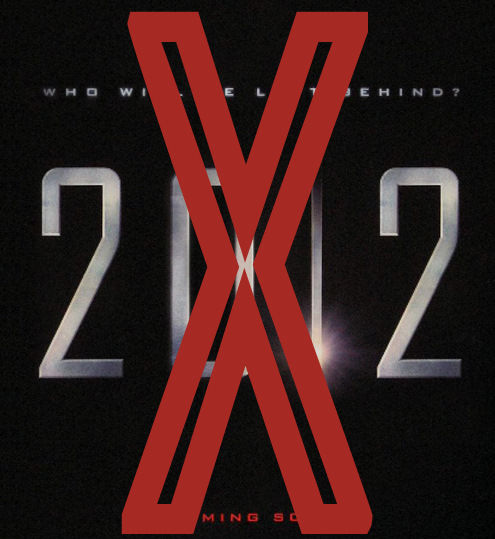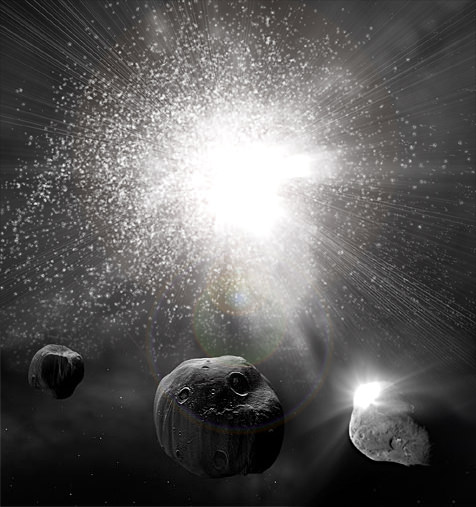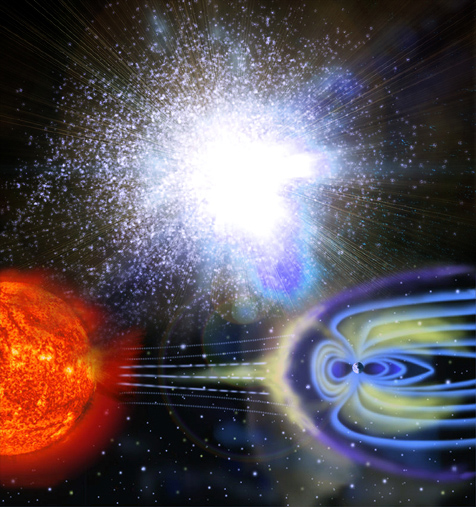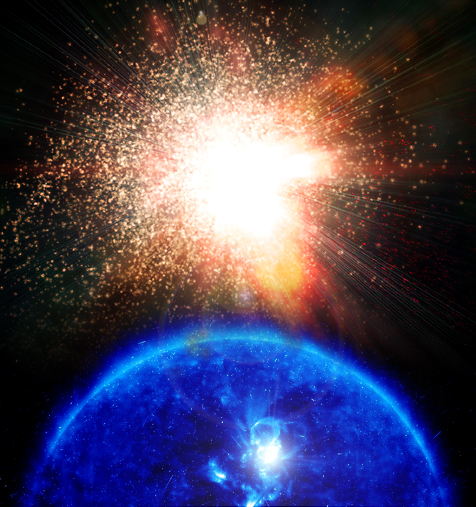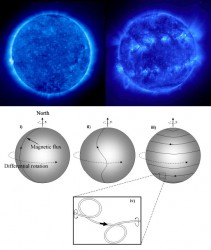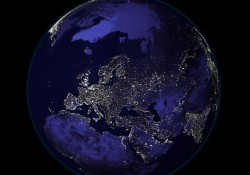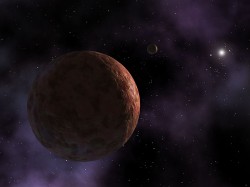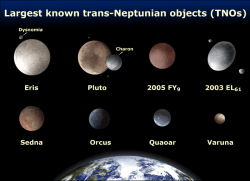Our very own resident expert on 2012, Dr. Ian O’Neill will be on a special Discovery Channel show, premiering Sunday evening. I just saw a promo piece on the Discovery Channel, and it looks really great. On TV, they called it Surviving 2012, however online it is titled Apocalypse 2012. On his blog, Astroengine, Ian says that science is the focus on this show, (unlike the idiotic Nostradamus nonsense on another channel). As you probably know, Ian is now the producer over at Discovery Space, (and doing a bang-up job!) but he still posts on UT now and then. His series of articles on 2012 are outstanding, and are some of our most popular articles, so I can’t wait to see him debunk the nonsense on television. The Discovery Channel in my area (US Central Time) says 8 pm, but check your own local listing. And if you miss it Sunday night, check for repeat showings later in the week. Go Ian!
2012: Combat the Nonsense
[/caption]
In a rather cruel media ploy, the creators of the upcoming science fiction movie “2012” are purposely feeding the flames of internet panic about the ridiculous claims that the world will end in 2012. This viral marketing campaign has created fake science websites and encourages people to search for “2012” on the Web. While there are many websites, like Universe Today, which provide solid and methodical evidence that the 2012 hysteria is complete nonsense, hordes of other sites out there are full of gobbledygook and a gross misstating of what they claim to be scientific evidence that some astronomical event will decimate our planet. Why are these hoaxers doing this? For the oldest reason ever: for profit and notoriety. If you visit their websites, most are trying to sell books or videos.
For those reading this article because you have concerns about 2012, we encourage you to read our complete series of articles on 2012, and it won’t cost you a thing. The articles were written by Dr. Ian O’Neil, who has a PhD in solar physics. Additionally, below is a list of other resources that should help answer any questions or concerns you may have on this topic:
1. NASA scientist Dr. David Morrison Dr. Morrison, a world-renowned expert on the solar system (and asteroid impacts) has published a free pdf, “Doomsday 2012, Planet Nibiru and Cosmophobia,” a concise summary of the claims and answers containing solid scientific responses. It is published by the Astronomical Society of the Pacific as a public service.
2. Morrison also serves as the public scientist for NASA’s “Ask an Astrobiologist” service, where he answers questions for the public. You’ll find many questions and answers about 2012 there, as well as other space topics.
3. The 365 Days of Astronomy podcast has a couple of great, short podcasts that address the 2012 claims, where you can get lots of information in about 10 minutes of your time. Will the World End in 2012? provides an overview of all 2012 doomsday hoaxes, and “Ancient Astronomy: The Mayans” discusses the significance of the Mayan calendar and, briefly, how the world is not going to end in 2012.
4. The Griffith Observatory has a great, concise page on the different claims called “The Truth About 2012: The End is NOT Near,” written by astronomer Dr. Ed Krupp.
5. “2012 Hoax” is a website written by several professional and amateur astronomers that thoroughly discusses the various doomsday scenarios and crackpot websites. You can also follow 20 12 2012 Hoax on Twitter.
6. Gia’s Blog, written by science groupie Gia Milinovitch (also married to physicist Dr. Brian Cox) has a great page titled “Apocalympics 2012: Mayan ‘Prophecy'”
7. If English isn’t your native language, astronomer Florian Freistetter has written several 2012 articles in German. They can be found on his website, Astrodicticum Simplex. Of special interest, Florian has recently put together a “2012 FAQ” page in German.
8. Daniel Fischer has a webpage in both English and German, Ist Es Wahr? Nachrichten vom Rande der Wirklichkeit (Is it true? News from the Edge of Reality), which tracks articles related to all sorts of doomsday and conspiracy theories.
9. (Added later) With the release of the Movie 2012, NASA published a short page that answers several doomsday predictions with concise, scientific answers.
Constraining the Orbits of Planet X and Nemesis
[/caption]
If Planet X was out there, where would it be? This question posed by an Italian researcher turns out to be a lot more involved than you’d think. As opposed to all the 2012 idiocy hype flying around on the internet, this research is actually based on a little thing called science. By analysing the orbital precession of all the inner-Solar System planets, the researcher has been able to constrain the minimum distance a hypothetical object, from the mass of Mars to the mass of the Sun, could be located in the Solar System. As most of the astronomical community already knows, the two purveyors of doom (Planet X and the Sun’s evil twin, Nemesis) exist only in the over-active imaginations of a few misinformed individuals, not in reality…
Planet X and Nemesis are hypothetical objects with more grounding in ancient prophecy and doomsday theories based on pseudo-science. This might be the case, but Planet X came from far more rational beginnings.
The name “Planet X” was actually coined by Percival Lowell at the start of the 20th century when he predicted there might be a massive planet beyond the orbit of Neptune. Then, in 1930, Clyde Tombaugh appeared to confirm Lowell’s theory; a planet had been discovered and it was promptly named Pluto. However, as time went on, it slowly became apparent that Pluto wasn’t massive enough to explain the original observations of the perturbations of Uranus’ orbit (the reason for Lowell’s Planet X prediction in the first place). By the 1970’s and 80’s modern observation techniques proved that the original perturbations in Uranus’ orbit were measurement error and not being caused by a massive planetary body. The hunt for Planet X pretty much ended with the discovery of Pluto in 1930, but it never lived up to its promise as a massive planetary body (despite what the woefully erroneous doomsday theories say otherwise).
Now an Italian researcher has published results from a study that examines the orbital dynamics of the inner-Solar System planets, and relates them to the gravitational influence of a massive planetary body orbiting the Sun from afar.
To cut a long story short, if a massive planetary body or a small binary sibling of the Sun were close to us, we would notice their gravitational influence in the orbital dynamics of the planets. There may be some indirect indications that a small planetary body might be shaping the Kuiper Cliff, and that a binary partner of the Sun might be disturbing the Oort Cloud every 25 million years or so (relating to the cyclical mass extinctions in Earth’s history, possibly caused by comet impacts), but hard astronomical proof has yet to be found.
Lorenzo Iorio from the National Institute of Nuclear Physics in Pisa (Italy) has taken orbital data from many years of precise observations and used his computations to predict the closest possible distance at which a massive planet could orbit if it was out there.
It turns out that all the planets the mass of Mars and above have been discovered within the Solar System. Iorio computes that the minimum possible distances at which a Mars-mass, Earth-mass, Jupiter-mass and Sun-mass object can orbit around the Sun are 62 AU, 430 AU, 886 AU and 8995 AU respectively. To put this into perspective, Pluto orbits the Sun at an average distance of 39 AU.
So if we used our imaginations a bit, we could say that a sufficiently sized Planet X could be patrolling a snail-paced orbit somewhere beyond Pluto. But there’s an additional problem for Planet X conspiracy theorists. If there was any object of sufficient size (and by “sufficient” I mean Pluto-mass, I’m being generous), according to a 2004 publication by David Jewitt, from the Institute for Astronomy, University of Hawaii, we would have observed such an object by now if it orbited within 320 AU from the Sun.
Suddenly, the suggestion that Planet X will be making an appearance in 2012 and the crazy idea that anything larger than a Pluto-sized object is currently 75 AU away seems silly. Sorry, between here and a few hundred AU away, it’s just us, the known planets and a load of asteroids (and perhaps the odd plutino) for company.
Source: arXiv, Astroengine.com
Another Voice Against 2012 Mania
The world is not going to end in 2012. If anyone reading this has any doubt about that, you need to read each and every one of Ian O’Neill’s articles here on Universe today about every facet of the 2012 mania. And then if you still have any doubts, here’s another voice you might recognize who will tell you the same thing: Dr. Neil deGrasse Tyson of the Hayden Planetarium and NOVA ScienceNow, has a few choice words for the entities out there spreading fear and disinformation (and looking to make a few bucks along the way) about everything that could possibly (not) happen in 2012.
I also recommend listening to the February 2, 2009 edition of The Planetary Society’s Planetary Radio, where David Morrison, Interim Director of the Lunar Science Institute and Planetary Radio host Mat Kaplan have a discussion (near the end of the show) about how the completely false claims of the 2012 fear mongers are needlessly scaring people. Its sobering.
2012: No Comet
[/caption]According to 2012 doomsday proponents, something big is out to get us. By “something big” I mean some uncontrollable cosmic entity (i.e. Planet X, Nibiru or a “killer” solar flare), and by “us” I mean the whole of planet Earth. Pinning 2012 doomsday scenarios on the end of the ancient Mayan “Long Count” calendar appears to be growing momentum amongst authors, websites, documentaries and (my personal favourite) YouTube videos. According to them, something bad is going to happen on or around December 21st 2012. Probably the most interesting difference between the 2012 doomsday scenario and the doomsday prophecies of the past is that almost every possible (and impossible… or implausible) harbinger of doom is being suggested as a planet killer.
So, in this sixth article addressing another astronomical doomsday scenario, I will look at the theory that there is a comet currently out there in deep space, slowly making its final approach on its parabolic orbit toward Earth. But before you get worried, you’ll be glad to hear that the 2012 cometary impact theory is as watertight as a teabag; there is no object observed out there and there is certainly no evidence to suggest there could be a comet impact in 2012… and here’s why…
Marketing Doomsday
In four years today (2012 21-December), the world will be coming to an end according to a few misguided individuals. Doomsayers always begin their arguments using an ancient calendar (plus a heavy dose of Bible Codes, I Ching and ancient Sumerian cuneiform scriptures) to support their new and inventive way the world may end. Alas, most doomsday theories are based on over-hyped scientific misinterpretation and outright lies. Usually there is a book to sell or website to promote. After all, there is nothing more profitable than fear.
Interestingly, I started writing for the Universe Today a year ago today, exactly five years before the end of the Mayan Long Count calendar. Don’t go reading too much into this little fact, pure coincidence, but I think it would be fitting to write the sixth in my series of 2012 articles exposing the myths surrounding this date.
You’ve probably seen the prolific ads for the “2012 Comet” across a range of websites, so I decided to delve into this particular theory to see if there is any truth behind the claims that a comet (or “comet planet”) is approaching Earth on a collision course. To cut a long story short, I can categorically say that no cometary impact is imminent. Any accusations of government cover-ups are to hide the poor science doomsayers are citing (much like the Planet X/Nibiru connection). If you want the long story, read on…
The Comet Threat

Although rare, planetary impacts by comets do happen. As Shoemaker-Levy 9 showed us in 1994 when 2km-wide fragments of the comet bombarded the Jovian atmosphere, we mustn’t be complacent when considering a large impact event by comets or asteroids. The dazzling light show by Shoemaker-Levy 9 actually stimulated efforts to increase sky surveys for a possibly catastrophic impact event. Although a vast number of near-Earth objects (NEOs) have been identified, a very small number are considered to be a risk.

The 270 meter-wide asteroid 99942 Apophis caused a stir in 2006 when it became the highest ranking asteroid on the Torino impact hazard scale. Apophis is now expected to glide safely past the Earth in 2029, but depending on the gravitational deflection caused by Earth in 2029, Apophis could pass through a gravitational “keyhole”, creating another impact possibility on April 13th, 2036. Still, the odds are not worth betting on; would you put money on a 1 in 45,000 chance of an Apophis 2036 impact?
There are other lumps of rock out there, but most are benign, and certainly not a threat to everyday life in 2012. However, we must be aware that asteroids are a very real future threat to humanity. As a result of this increased awareness, other NEOs have been discovered and tracked. Objects such as 2007 VK184, a 130 meter-wide asteroid may cause problems in the distant future, but the probability of impact is still extremely low. Astronomers from the Catalina Sky Survey estimate a few possible impact dates for 2007 VK184, but the odds never exceed a 0.037% chance of hitting Earth in the next 100 years. Other asteroids are currently being tracked and they may cause some concern over a century from now (although none surpass a Torino scale of Level 1, and if they do, all tend to fall back to the “normal” Level 0).
In short, the skies are clear from any imminent (certainly within the next 4 years) impact from an asteroid. Comets do not feature as a significant risk either. There is no astronomical evidence supporting otherwise.
This doesn’t stop organizations such as ex-NASA astronaut Rusty Schweickart’s B612 Foundation from planning for possible future asteroid/comet threats. While Hollywood movies would have us believe blowing a comet up with a nuclear bomb will be a very good idea, the B612 Foundation disagrees. In fact, it could be a very bad idea. The key thing to remember when reading about NEO surveys or asteroid/comet deflection techniques is that we need a lot of lead time to stand any hope of deflecting a possible catastrophic impact event. This does not indicate a concern in the near future, it is simply a prudent precaution to safeguard the distant future of our planet.
The 2012 Comet-Google Conspiracy

So why are we seeing ads touting the “2012 Comet” theory? As far as I can tell, it is based on one very flimsy piece of evidence. So, lets load up Google Earth to see where the problem is…
If you have Google Earth installed on your computer, you have the ability to look “up” rather than just down at the Earth’s surface. Switching the software to the night sky allows you to see the constellations and will guide you and a dazzling tour of the observable Universe. Despite this overload of information, is Google hiding something? Is the huge search-engine based company actively trying to hide observations of a comet from us?

Guide Google Earth to RA:5h 54m 00s, Dec: -6° 00′ 00″ and zoom in. If you don’t have Google Earth, this region can also be found in the online version of Google Sky. You’ll see an ominous rectangular void (a.k.a. the “Google Anomaly” in the images above) right next to the Orion Nebula, south of Orion’s Belt.
Note: The Constellation of Orion and therefore the “Google Anomaly” is in a very conspicuous location of the night sky, observable from northern and southern hemispheres.
This void is only apparent in the optical data; if you switch the data set to the microwave survey carried out by the Wilkinson Microwave Anisotropy Probe (WMAP), you’ll find the void is replaced by data. Also, infrared data covers the region pretty nicely.
Note: This infrared view of the sky was observed by the Infrared Astronomical Satellite (IRAS).
So, the theory is that Google is hiding observations of an incoming comet. But there is an added twist to the comet conspiracy theory; the comet is also referred to as a “comet planet” and therefore a Planet X candidate (but I thought Planet X was a brown dwarf candidate?). Yes, Planet X seems to be at the root of all doomsday scenarios.
I’ll try to make this as quick as possible:
1) IRAS Data

So, is this “2012 comet” actually Planet X? If it is (disregarding the obvious fact that a comet is not a planet, let alone a brown dwarf), why is the Google Anomaly only a void patch in optical data? If Google and NASA were trying to hide evidence of a “comet” (by removing a region of optical data), surely they’d remove the IRAS data too? In any case, the IRAS data shows no object within the anomaly. Besides, why would Google leave a very obvious patch of missing optical data, when they could have just airbrushed the object from the dataset?
In conclusion, the Google Anomaly is in fact missing data, pure and simple. There’s no comet there, and simply because there is missing data does not prove the existence of anything sinister.
2) Just Look Up
Just in case you needed a little more convincing that the 2012 comet/Planet X theory was complete bunkum, think about the location of this proposed comet. The Google Anomaly is in full view for most of the planet throughout the year as it is in the constellation of Orion, right in the neighbourhood of some of the most famous, and well-studied stars and nebulae (the Horsehead Nebula and the Great Orion Nebula for example). If anyone looks at the Google Anomaly with suspicion, why not look straight up and see for yourself? Amateur astronomers have access to very advanced optics, so I think that if there was a suspect “comet planet” in the region, it would have been spotted by now (without Google’s help).
In Conclusion
The truth is that the Planet X conspiracy theory is wrong, but the 2012 comet theory is even worse. The chances of a large planet swinging through the inner solar system in 2012 has the same odds as a comet impact on that date: nil.
We cannot predict the future, and no ancient prophecy will prove the existence of a modern astronomical “end of the world” scenario. I am sure 2012 will be a significant year for spiritual and religious reasons, I’m not debating that. However, for doomsayers to use modern science to prove their inaccurate doomsday creations for personal gain is not only irresponsible, it can be very damaging.
Comments for 2012: No Planet X
Because of the huge number of comments on this article, it was slowing down the server. I’ve created a separate thread here where people can continue their discussions on the story.
2012: No Geomagnetic Reversal
[/caption]Apparently, on December 21st 2012, our planet will experience a powerful event. This time we’re not talking about Planet X, Nibiru or a “killer” solar flare, this event will originate deep within the core of our planet, forcing a catastrophic change in our protective magnetic field. Not only will we notice a rapid reduction in magnetic field strength, we’ll also see the magnetic poles rapidly reverse polarity (i.e. the north magnetic pole will be located over the South Pole and vice versa). So what does this mean to us? If we are to believe the doomsayers, we’ll be exposed to the vast quantities of radiation blasting from the Sun; with a reversing magnetic field comes a weakening in the Earth’s ability to deflect cosmic rays. Our armada of communication and military satellites will drop from orbit, adding to the chaos on the ground. There will be social unrest, warfare, famine and economic collapse. Without GPS, our airliners will also plough into the ground…
Related 2012 articles:
- 2012: No Geomagnetic Reversal (posted October 3rd 2008)
- 2012: No Killer Solar Flare (posted June 21st 2008)
- 2012: Planet X Is Not Nibiru (posted June 19th 2008)
- 2012: No Planet X (posted May 25th 2008)
- No Doomsday in 2012 (posted May 19th 2008)
Using the Mayan Prophecy as an excuse to create new and explosive ways in which our planet may be destroyed, 20 12 2012 doomsayers use the geomagnetic shift theory as if it is set in stone. Simply because scientists have said that it might happen within the next millennium appears to be proof enough that it will happen in four years time. Alas, although this theory has some scientific backing, there is no way that anyone can predict when geomagnetic reversal might happen to the nearest day or to the nearest million years…
Firstly, let’s differentiate between geomagnetic reversal and polar shift. Geomagnetic reversal is the change in the magnetic field of the Earth, where the magnetic north pole shifts to the South Polar Region and the south magnetic pole shifts to the North Polar Region. Once this process is complete, our compasses would point toward Antarctica, rather than northern Canada. Polar shift is considered to be a less likely event that occurs a few times in the evolutionary timescale of the Solar System. There are a couple of examples of planets that have suffered a catastrophic polar shift, including Venus (which rotates in an opposite direction to all the other planets, therefore it was flipped upside down by some huge event, such as a planetary collision) and Uranus (which rotates on its side, having been knocked off-axis by an impact, or some gravitational effect caused by Jupiter and Saturn). Many authors (including the doomsayers themselves) often cite both geomagnetic reversal and polar shift as being one of the same thing. This isn’t the case.
So, on with geomagnetic reversal…
How often does it happen?
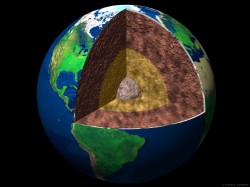
This magnetic field passes through the core to the crust and pushes into space as the Earth’s magnetosphere, a protective bubble constantly being buffeted by the solar wind. As the solar wind particles are usually charged, the Earth’s powerful magnetosphere deflects the particles, only allowing them into the polar cusp regions where the polar magnetic fieldlines become “open.” The regions at which these energetic particles are allowed to enter glow as aurorae.
Usually this situation can last for aeons (a stable magnetic field threaded through the North and South Polar Regions), but occasionally, the magnetic field is known to reverse and alter in strength. Why is this?

Again, we simply do not know. We do know that this magnetic pole flip-flop has occurred many times in the last few million years, the last occurred 780,000 years ago according to ferromagnetic sediment. A few scaremongering articles have said geomagnetic reversal occurs with “clockwork regularity” – this is simply not true. As can be seen from the diagram (left), magnetic reversal has occurred fairly chaotically in the last 160 million years. Long-term data suggests that the longest stable period between magnetic “flips” is nearly 40 million years (during the Cretaceous period over 65 million years BC) and the shortest is a few hundred years.
Some 2012 theories suggest that the Earth’s geomagnetic reversal is connected to the natural 11-year solar cycle. Again, there is absolutely no scientific evidence to support this claim. No data has ever been produced suggesting a Sun-Earth magnetic polarity change connection.
So, already this doomsday theory falters in that geomagnetic reversal does not occur with “clockwork regularity,” and it has no connection with solar dynamics. We are not due a magnetic flip as we cannot predict when the next one is going to occur, magnetic reversals occur at seemingly random points in history.
What causes geomagnetic reversal?
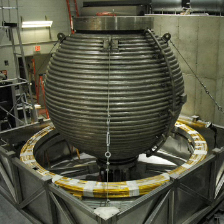
In a previous Universe Today article, we discussed the efforts of geophysicist Dan Lathrop’s attempts to create his own “model Earth,” setting a 26 tonne ball (containing a molten iron analogue, sodium) spinning to see if the internal motion of the fluid could set up a magnetic field. This huge laboratory experiment is testament to the efforts being put into understanding how our Earth even generates a magnetic field, let alone why it randomly reverses.
A minority view (which, again is used by doomsayers to link geomagnetic reversal with Planet X) is that there may be some external influence that causes the reversal. You will often see associated with the Planet X/Nibiru claims that should this mystery object encounter the inner Solar System during its highly elliptical orbit, the magnetic field disturbance could upset the internal dynamics of the Earth (and the Sun, possibly generating that “killer” solar flare I discussed back in June). This theory is a poor attempt to link several doomsday scenarios with a common harbinger of doom (i.e. Planet X). There is no reason to think the strong magnetic field of the Earth can be influenced by any external force, let alone a non-existent planet (or was that a brown dwarf?).
The magnetic field strength waxes and wanes…
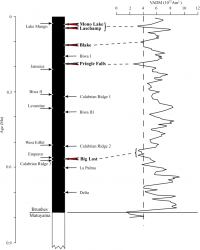
The Earth’s magnetic field is measured to vary in field strength and it is a well known fact that the magnetic field strength is currently experiencing a downward trend. The new research paper, co-authored by geochronologist Brad Singer of the University of Wisconsin, suggests that the weaker magnetic field is critical to geomagnetic reversal. Should the stronger dipole (north-south) field reduce below the magnetic field strength of this usually weaker, distributed field, a geomagnetic reversal is possible.
“The field is not always stable, the convection and the nature of the flow changes, and it can cause the dipole that’s generated to wax and wane in intensity and strength,” Singer said. “When it becomes very weak, it’s less capable of reaching to the surface of the Earth, and what you start to see emerge is this non-axial dipole, the weaker part of the field that’s left over.” Singer’s research group analysed samples of ancient lava from volcanoes in Tahiti and Germany between 500,000 and 700,000 years ago. By looking at an iron-rich mineral called magnetite in the lava, the researchers were able to deduce the direction of the magnetic field.
The spin of the electrons in the mineral is governed by the dominant magnetic field. During times of strong dipolar field, these electrons pointed toward the magnetic North Pole. During times of weak dipolar field, the electrons pointed to wherever the dominant field was, in this case the distributed magnetic field. They think that when the weakened dipolar field drops below a certain threshold, the distributed field pulls the dipolar field off-axis, causing a geomagnetic shift.
“The magnetic field is one of the most fundamental features of the Earth,” Singer said. “But it’s still one of the biggest enigmas in science. Why [the flip] happens is something people have been chasing for more than a hundred years.”
Our meandering magnetic pole
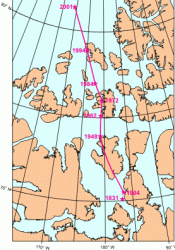
The positions of the magnetic poles are also known to be wondering over Arctic and Antarctic locations. Take the magnetic north pole for example (pictured left); it has accelerated north over the Canadian plains from 10 km per year in the 20th Century to 40 km per year more recently. It is thought that if the point of magnetic north continues this trend, it will exit North America and enter Siberia in a few decades time. This is not a new phenomenon however. Ever since James Ross’ discovery of the location of the north magnetic pole for the first time in 1831, it’s location has meandered hundreds of miles (even though today’s measurements show some acceleration).
So, no doomsday then?
Geomagnetic reversal is an engrossing area of geophysical research that will continue to occupy physicists and geologists for many years to come. Although the dynamics behind this event are not fully understood, there is absolutely no scientific evidence supporting the claim that there could be a geomagnetic reversal around the time of December 21st, 2012.
Besides, the effects of such a reversal have been totally over-hyped. Should we experience geomagnetic reversal in our lifetimes (which we probably won’t), it is unlikely that we’ll be cooked alive by the Solar Wind, or be wiped out by cosmic rays. It is unlikely that we’ll suffer any mass extinction event (after all, early man, homo erectus, lived through the last geomagnetic shift, apparently with ease). We’ll most likely experience aurorae at all latitudes whilst the dipolar magnetic field settles down to its new, reversed state, and there might be a small increase in energetic particles from space (remember, just because the magnetosphere is weakened, doesn’t mean we wont have magnetic protection), but we’ll still be (largely) protected by our thick atmosphere.
Satellites may malfunction and migrating birds may become confused, but to predict world collapse is a hard pill to swallow.
In conclusion:
- Geomagnetic reversal is chaotic in nature. There is no way we can predict it.
- Simply because the magnetic field of the Earth is weakening does not mean it is near collapse. Geomagnetic field strength is “above average” if we compare today’s measurements with the last few million years.
- The magnetic poles are not set in geographical locations, they move (at varying speeds) and have done ever since measurements began.
- There is no evidence to suggest external forcing of internal geomagnetic dynamics of the Earth. Therefore there is no evidence of the solar cycle-geomagnetic shift connection. Don’t get me started on Planet X.
So, do you think there will be a geomagnetic reversal event in 2012? I thought not.
Once again, we find another 2012 doomsday scenario to be flawed in so many ways. There is no doubt that geomagnetic reversal will happen in the future for Earth, but we’re talking about time scales anything from an optimistic (and unlikely) 500 years to millions of years, certainly not in the coming four years…
Sources: NASA, US News, SciVee, How To Survive 2012, AGU
Comments for 2012: No Geomagnetic Reversal
Because of the enormous amount of comments to this 2012 article, I’ve had to move the comments to a separate thread, because the page was slowing down the server. You can continue commenting here.
2012: No Killer Solar Flare
We could be in for a huge firework display in 2012. The Sun will be approaching the peak of its 11-year cycle, called “solar maximum”, so we can expect a lot of solar activity. Some predictions put the solar maximum of Solar Cycle 24 even more energetic than the last solar maximum in 2002-2003 (remember all those record breaking X-class flares?). Solar physicists are already getting excited about this next cycle and new prediction methods are being put to good use. But should we be worried?
Related 2012 articles:
- 2012: No Geomagnetic Reversal (posted October 3rd 2008)
- 2012: No Killer Solar Flare (posted June 21st 2008)
- 2012: Planet X Is Not Nibiru (posted June 19th 2008)
- 2012: No Planet X (posted May 25th 2008)
- No Doomsday in 2012 (posted May 19th 2008)
According to one of the many Doomsday scenarios we have been presented with in the run-up to the Mayan Prophecy-fuelled “end of the world” in the year 2012, this scenario is actually based on some science. What’s more, there may be some correlation between the 11-year solar cycle and the time cycles seen in the Mayan calendar, perhaps this ancient civilization understood how the Sun’s magnetism undergoes polarity changes every decade or so? Plus, religious texts (such as the Bible) say that we are due for a day of judgement, involving a lot of fire and brimstone. So it looks like we are going to get roasted alive by our closest star on December 21st, 2012!
Before we go jumping to conclusions, take a step back and think this through. Like most of the various ways the world is going to end in 2012, the possibility of the Sun blasting out a huge, Earth-damaging solar flare is very attractive to the doomsayers out there. But let’s have a look at what really happens during an Earth-directed solar flare event, the Earth is actually very well protected. Although some satellites may not be…
The Earth has evolved in a highly radioactive environment. The Sun constantly fires high-energy particles from its magnetically dominated surface as the solar wind. During solar maximum (when the Sun is at its most active), the Earth may be unlucky enough to be staring down the barrel of an explosion with the energy of 100 billion Hiroshima-sized atomic bombs. This explosion is known as a solar flare and the effects of which can cause problems here on Earth.
Before we look at the Earth-side effects, let’s have a look at the Sun and briefly understand why it gets so angry every 11 years or so.
First and foremost, the Sun has a natural cycle with a period of approximately 11 years. During the lifetime of each cycle, the magnetic field lines of the Sun are dragged around the solar body by differential rotation at the solar equator. This means that the equator is spinning faster than the magnetic poles. As this continues, solar plasma drags the magnetic field lines around the Sun, causing stress and a build up of energy (an illustration of this is pictured). As magnetic energy increases, kinks in the magnetic flux form, forcing them to the surface. These kinks are known as coronal loops which become more numerous during periods of high solar activity.
This is where the sunspots come in. As coronal loops continue to pop up over the surface, sunspots appear too, often located at the loop footpoints. Coronal loops have the effect of pushing the hotter surface layers of the Sun (the photosphere and chromosphere) aside, exposing the cooler convection zone (the reasons why the solar surface and atmosphere is hotter than the solar interior is down to the coronal heating phenomenon). As magnetic energy builds up, we can expect more and more magnetic flux to be forced together. This is when a phenomenon known as magnetic reconnection occurs.
Reconnection is the trigger for solar flares of various sizes. As previously reported, solar flares from “nanoflares” to “X-class flares” are very energetic events. Granted, the largest flares my generate enough energy for 100 billion atomic explosions, but don’t let this huge figure concern you. For a start, this flare occurs in the low corona, right near the solar surface. That’s nearly 100 million miles away (1AU). The Earth is nowhere close to the blast.
As the solar magnetic field lines release a huge amount of energy, solar plasma is accelerated and confined within the magnetic environment (solar plasma is superheated particles like protons, electrons and some light elements such as helium nuclei). As the plasma particles interact, X-rays may be generated if the conditions are right and bremsstrahlung is possible. (Bremsstrahlung occurs when charged particles interact, resulting in X-ray emission.) This may create an X-ray flare.
The Problem with X-ray Solar Flares
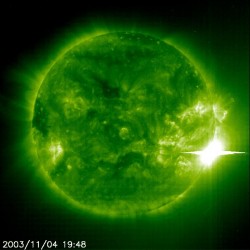
The biggest problem with an X-ray flare is that we get little warning when it is going to happen as X-rays travel at the speed of light (one of the record breaking 2003 solar flares is pictured left). X-rays from an X-class flare will reach the Earth in around eight minutes. As X-rays hit our atmosphere, they are absorbed in the outermost layer called the ionosphere. As you can guess from the name, this is a highly charged, reactive environment, full of ions (atomic nuclei, and free electrons).
During powerful solar events such as flares, rates of ionization between X-rays and atmospheric gases increase in the D and E region layers of the ionosphere. There is a sudden surge in electron production in these layers. These electrons can cause interference to the passage of radio waves through the atmosphere, absorbing short wave radio signals (in the high frequency range), possibly blocking global communications. These events are known as “Sudden Ionospheric Disturbances” (or SIDs) and they become commonplace during periods of high solar activity. Interestingly, the increase in electron density during a SID boosts the propagation of Very Low Frequency (VLF) radio, a phenomenon scientists use to measure the intensity of X-rays coming from the Sun.
Coronal Mass Ejections?
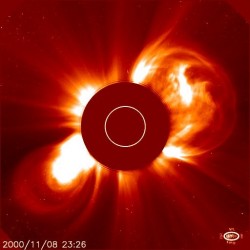
X-ray solar flare emissions are only part of the story. If the conditions are right, a coronal mass ejection (CME) might be produced at the site of the flare (although either phenomenon can occur independently). CMEs are slower than the propagation of X-rays, but their global effects here on Earth can be more problematic. They may not travel at the speed of light, but they still travel fast; they can travel at a rate of 2 million miles per hour (3.2 million km/hr), meaning they may reach us in a matter of hours.
This is where much effort is being put into space weather prediction. We have a handful of spacecraft sitting between the Earth and the Sun at the Earth-Sun Lagrangian (L1) point with sensors on board to measure the energy and intensity of the solar wind. Should a CME pass through their location, energetic particles and the interplanetary magnetic field (IMF) can be measured directly. One mission called the Advanced Composition Explorer (ACE) sits in the L1 point and provides scientists with up to an hour notice on the approach of a CME. ACE teams up with the Solar and Heliospheric Observatory (SOHO) and the Solar TErrestrial RElations Observatory (STEREO), so CMEs can be tracked from the lower corona into interplanetary space, through the L1 point toward Earth. These solar missions are actively working together to provide space agencies with advanced notice of an Earth-directed CME.
So what if a CME reaches Earth? For a start, much depends on the magnetic configuration of the IMF (from the Sun) and the geomagnetic field of the Earth (the magnetosphere). Generally speaking, if both magnetic fields are aligned with polarities pointing in the same direction, it is highly probable that the CME will be repelled by the magnetosphere. In this case, the CME will slide past the Earth, causing some pressure and distortion on the magnetosphere, but otherwise passing without a problem. However, if the magnetic field lines are in an anti-parallel configuration (i.e. magnetic polarities in opposite directions), magnetic reconnection may occur at the leading edge of the magnetosphere.
In this event, the IMF and magnetosphere will merge, connecting the Earth’s magnetic field with the Sun’s. This sets the scene for one of the most awe inspiring events in nature: the aurora.
Satellites in Peril
As the CME magnetic field connects with the Earth’s, high energy particles are injected into the magnetosphere. Due to solar wind pressure, the Sun’s magnetic field lines will fold around the Earth, sweeping behind our planet. The particles injected in the “dayside” will be funnelled into the polar regions of the Earth where they interact with our atmosphere, generating light as aurorae. During this time, the Van Allen belt will also become “super-charged”, creating a region around the Earth that could cause problems to unprotected astronauts and any unshielded satellites. For more on the damage that can be caused to astronauts and spacecraft, check out “Radiation Sickness, Cellular Damage and Increased Cancer Risk for Long-term Missions to Mars” and “New Transistor Could Side-Step Space Radiation Problem.”
As if the radiation from the Van Allen belt wasn’t enough, satellites could succumb to the threat of an expanding atmosphere. As you’d expect, as if the Sun hits the Earth with X-rays and CMEs, there will be inevitable heating and global expansion of the atmosphere, possibly encroaching into satellite orbital altitudes. If left unchecked, an aerobraking effect on satellites could cause them to slow and drop in altitude. Aerobraking has been used extensively as a space flight tool to slow spacecraft down when being inserted into orbit around another planet, but this will have an adverse effect on satellites orbiting Earth as any slowing of velocity could cause it to re-enter the atmosphere.
We Feel the Effects on the Ground Too
Although satellites are on the front line, if there is a powerful surge in energetic particles entering the atmosphere, we may feel the adverse effects down here on Earth too. Due to the X-ray generation of electrons in the ionosphere, some forms of communication may become patchy (or be removed all together), but this isn’t all that can happen. Particularly in high-latitude regions, a vast electric current, known as an “electrojet”, may form through the ionosphere by these incoming particles. With an electric current comes a magnetic field. Depending on the intensity of the solar storm, currents may be induced down here on the ground, possibly overloading national power grids. On March 13th 1989, six million people lost power in the Quebec region of Canada after a huge increase in solar activity caused a surge from ground-induced currents. Quebec was paralysed for nine hours whilst engineers worked on a solution to the problem.
Can Our Sun Produce a Killer Flare?
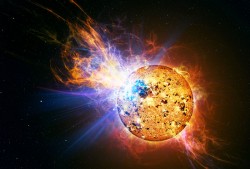
The short answer to this is “no”.
The longer answer is a little more involved. Whilst a solar flare from out Sun, aimed directly at us, could cause secondary problems such as satellite damage and injury to unprotected astronauts and blackouts, the flare itself is not powerful enough to destroy Earth, certainly not in 2012. I dare say, in the far future when the Sun begins to run out of fuel and swell into a red giant, it might be a bad era for life on Earth, but we have a few billion years to wait for that to happen. There could even be the possibility of several X-class flares being launched and by pure bad luck we may get hit by a series of CMEs and X-ray bursts, but none will be powerful to overcome our magnetosphere, ionosphere and thick atmosphere below.
“Killer” solar flares have been observed on other stars. In 2006, NASA’s Swift observatory saw the largest stellar flare ever observed 135 light-years away. Estimated to have unleashed an energy of 50 million trillion atomic bombs, the II Pegasi flare will have wiped out most life on Earth if our Sun fired X-rays from a flare of that energy at us. However, our Sun is not II Pegasi. II Pegasi is a violent red giant star with a binary partner in a very close orbit. It is believed the gravitational interaction with its binary partner and the fact II Pegasi is a red giant is the root cause behind this energetic flare event.
Doomsayers point to the Sun as a possible Earth-killer source, but the fact remains that our Sun is a very stable star. It does not have a binary partner (like II Pegasi), it has a predictable cycle (of approximately 11 years) and there is no evidence that our Sun contributed to any mass extinction event in the past via a huge Earth-directed flare. Very large solar flares have been observed (such as the 1859 Carrington white light flare)… but we are still here.
In an added twist, solar physicists are surprised by the lack of solar activity at the start of this 24th solar cycle, leading to some scientists to speculate we might be on the verge of another Maunder minimum and “Little Ice Age”. This is in stark contrast to NASA solar physicist’s 2006 prediction that this cycle will be a “doozy”.
This leads me to conclude that we still have a long way to go when predicting solar flare events. Although space weather prediction is improving, it will be a few years yet until we can read the Sun accurately enough to say with any certainty just how active a solar cycle is going to be. So, regardless of prophecy, prediction or myth, there is no physical way to say that the Earth will be hit by any flare, let alone a big one in 2012. Even if a big flare did hit us, it will not be an extinction event. Yes, satellites may be damaged, causing secondary problems such as a GPS loss (which might disrupt air traffic control for example) or national power grids may be overwhelmed by auroral electrojets, but nothing more extreme than that.
But hold on, to sidestep this issue, doomsayers now tell us that a large solar flare will hit us just as the Earth’s geomagnetic field weakens and reverses, leaving us unprotected from the ravages of a CME… The reasons why this is not going to happen in 2012 is worthy of its own article. So, look out for the next 2012 article “2012: No Geomagnetic Reversal“.
Leading image credits: MIT (supernova simulation), NASA/JPL (solar active region in EUV). Effects and editing: myself.
2012: Planet X is not Nibiru
The Solar System’s outer reaches still contain many minor planets yet to be discovered. Ever since the search for Planet X began in the early 20th Century, the possibility of a hypothetical planet orbiting the Sun beyond the Kuiper Belt has fuelled many Doomsday theories and speculation that Planet X is actually the Sun’s long lost binary sibling. But why the fear about the Planet X/Doomsday combination? Surely Planet X is just an unknown, hypothetical object and nothing sinister?
Related 2012 articles:
- 2012: No Geomagnetic Reversal (posted October 3rd 2008)
- 2012: No Killer Solar Flare (posted June 21st 2008)
- 2012: Planet X Is Not Nibiru (posted June 19th 2008)
- 2012: No Planet X (posted May 25th 2008)
- No Doomsday in 2012 (posted May 19th 2008)
As I’ve previously discussed in “2012: No Planet X“, doomsayers have linked the modern day search for Planet X, the ancient Mayan 2012 Prophecy and the Sumerian mythical planet Nibiru, culminating in bad news for December 21st 2012. However, the astronomical evidence for these links is seriously flawed.
Yesterday (Wednesday, June 18th), Japanese researchers announced news that their theoretical search for a large mass in the outer Solar System has produced results. From their calculations, there might just be a planet, possibly a bit bigger than a Plutoid but certainly smaller than Earth orbiting beyond 100 AU from the Sun. But before we get carried away, this is not Nibiru, this is not proof of the end of the world in 2012; it is a new and very exciting development in the search for minor planets beyond the Kuiper Belt…
In a new theoretical simulation, two researchers have deduced that the outermost reaches of the Solar System may contain an undiscovered planet. Patryk Lykawka and Tadashi Mukai of Kobe University have published a paper in the Astrophysical Journal detailing a minor planet that they believe may be interacting with the mysterious Kuiper Belt.
The Kuiper Belt occupies a huge region of space, approximately 30-50 AU from the Sun. It contains a vast number of rocky and metallic objects, the largest known body being the dwarf planet (or “Plutoid”) Eris. It has been known for many years that the Kuiper Belt has a few strange characteristics that may signal the presence of another large planetary body orbiting the Sun beyond the Kuiper Belt. One such feature is the aptly named “Kuiper Cliff” that occurs at 50 AU. This is an abrupt end to the Kuiper Belt, very few Kuiper Belt objects (or KBOs) have been observed beyond this point. This cliff cannot be attributed to orbital resonances with massive planets such as Neptune, and there doesn’t appear to be any obvious observational error. Many astronomers believe that such a sharp cut-off in KBO population may be due to an as-yet to be discovered planet, possibly as large as Earth. This is an object Lykawka and Mukai believe they have calculated to exist.
This research predicts a large object, 30-70% the mass of the Earth, orbiting at a distance of around 100-200 AU from the Sun. This object may also help explain why some KBOs and tran-Neptunian objects (TNOs) have some strange orbital characteristics (such as Sedna).
Ever since Pluto was discovered in 1930, astronomers have been looking for another more massive body that could explain the orbital perturbations observed in the orbits of Neptune and Uranus. This search became known as the “search for Planet X”, which literally meant the “search for an as yet unidentified planet.” In the 1980’s these perturbations were put down to observational error. Therefore, the modern-day scientific search for Planet X is the search for a large KBO or a minor planet beyond. Although Planet X may not be larger than the mass of the Earth, researchers are still very excited about finding more KBOs, possibly the size of a Plutoid, possibly a little bigger, but not much bigger.
“The interesting thing for me is the suggestion of the kinds of very interesting objects that may yet await discovery in the outer solar system. We are still scratching the edges of that region of the solar system, and I expect many surprises await us with the future deeper surveys.” – Mark Sykes, Director of the Planetary Science Institute in Arizona.
Planet X is not scary
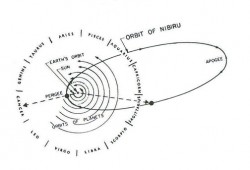
So where does Nibiru come in? Back in 1976 a controversial book called “The Twelfth Planet” was written by Zecharia Sitchin. Sitchin had interpreted some ancient Sumerian cuneiform texts (the earliest known form of writing) as a literal translation of the origin of humankind. These 6000 year old texts apparently reveal that an alien race known as the Annunaki travelled to Earth on a planet called Nibiru. It’s a long and involved story, but in a nutshell, the Anunnaki genetically modified primates on Earth to create homo sapiens to be their slaves. (I just worked out where the storyline for Kurt Russell’s 1994 movie Stargate probably came from…)
When the Anunnaki left Earth, they let us rule the planet until they return. All this may seem a little fantastical, and perhaps a little too detailed when considering it is a literal translation from 6000 year old texts. Sitchin’s work has been disregarded by the scientific community as many of his methods of interpretation are considered imaginative at best. Nevertheless, many people have taken Sitchin’s work literally, and believe Nibiru (in its highly eccentric orbit around the Sun) will be returning, possibly as soon as 2012 to cause all sorts of terror and destruction here on Earth. It is important to note here that I am not calling into question any archaeological, spiritual or historic evidence for Nibiru, I am simply pointing out the link between the 2012 Doomsday Planet X theory is based on very dubious astronomical “discoveries”; if this is the case, how can Planet X be considered to be the embodiment of Nibiru?
Then there’s the IRAS “discovery of a brown dwarf in the outer Solar System” in 1984 and the “NASA announcement of a 4-8 Earth mass planet travelling toward Earth” in 1993. Doomsayers (often with a book to sell) cling on to these astronomical discoveries as proof that Nibiru is in fact the Planet X astronomers have been searching for over the last century. Not only that, by manipulating the facts about these scientific studies, they “prove” that Nibiru is travelling toward us, and by 2012, this massive body will pass through the inner Solar System, causing all sorts of gravitational damage. For more information on this topic, see “2012: No Planet X.”
In its purest form, Planet X is an unknown, theoretically possible planet orbiting peacefully beyond the Kuiper Belt. If yesterday’s announcement does lead to the observation of a planet or Plutoid, it will be an incredible discovery that will help to shed some light on the evolution and characteristics of the mysterious outer reaches of the Solar System.
But as I write, I can guarantee that doomsayers are adapting this new research to be used as support for their nonsensical theories that Planet X is in fact Nibiru, and it’s coming in our direction by 20 12 2012. Why do I get the feeling we’ll still be here in the year 2013?
Leading image credits: MIT (supernova simulation), NASA (Pluto and Charon). Effects and editing: myself.


